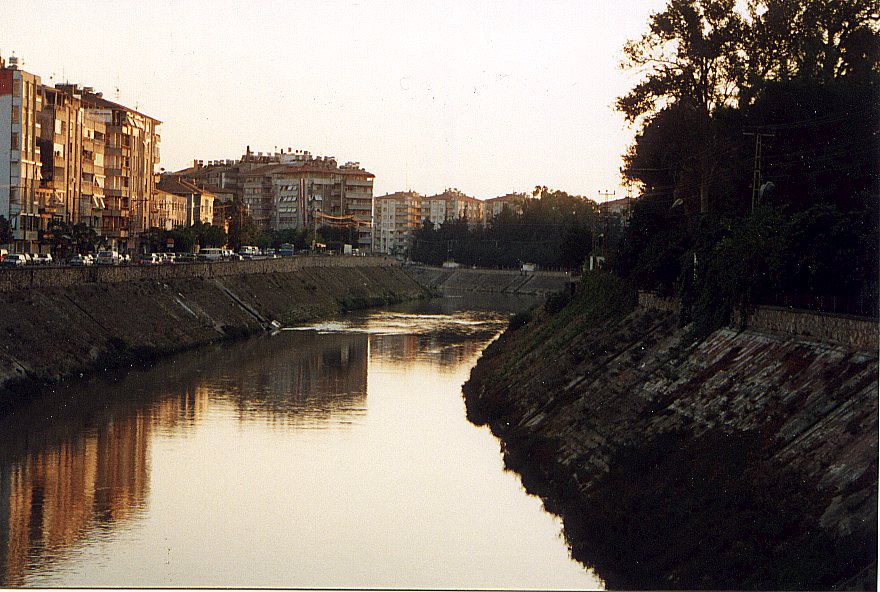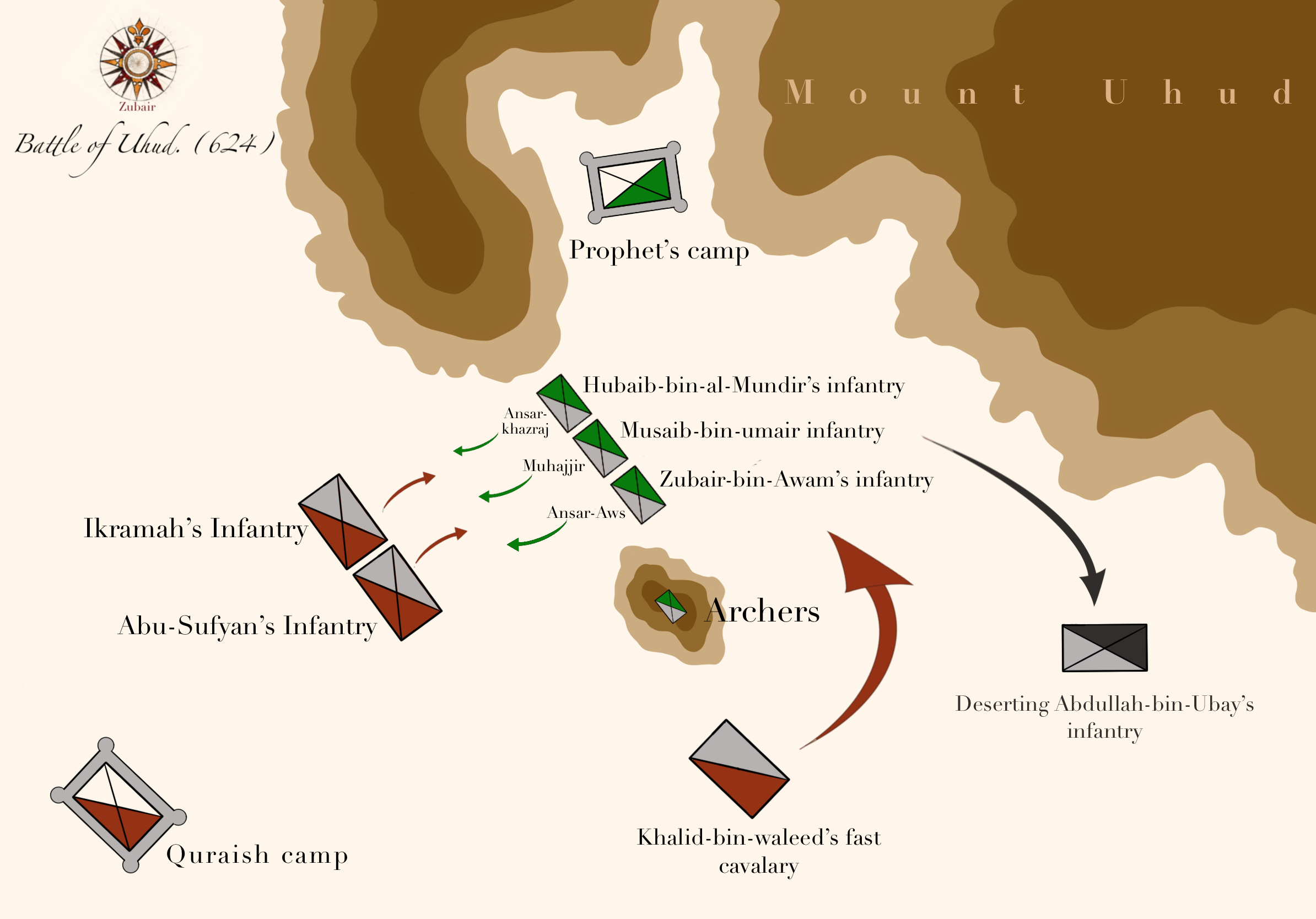|
Battle Of Iron Bridge
The Battle of the Iron Bridge was fought between the Muslim Rashidun army and the Byzantine army in 637 AD. The battle took its name from a nearby nine-arch stone bridge (also known as Jisr al-Hadid) spanning the Orontes River which had gates trimmed with iron. It was one of the last battles fought between the Byzantines and Rashidun Caliphate in the province of Syria. The aftermath of the battle marked the nearly complete annexation of the province into the Rashidun Caliphate with the fall of its capital. Background The Rashidun army had achieved a decisive victory at the Battle of Yarmouk. Following this victory, they managed to gain control of the Levant. Jerusalem was conquered shortly afterwards. Rashidun forces then marched north, conquering other portions of the Levant. They penetrated into northern Syria near its borders with Anatolia intending to capture Antioch, and to secure the conquered lands from any possible threat from the north. After the conquest of Alepp ... [...More Info...] [...Related Items...] OR: [Wikipedia] [Google] [Baidu] |
Arab–Byzantine Wars
The Arab–Byzantine wars were a series of wars between a number of Muslim Arab dynasties and the Byzantine Empire between the 7th and 11th centuries AD. Conflict started during the initial Muslim conquests, under the expansionist Rashidun and Umayyad caliphs, in the 7th century and continued by their successors until the mid-11th century. The emergence of Muslim Arabs from Arabia in the 630s resulted in the rapid loss of Byzantium's southern provinces ( Syria and Egypt) to the Arab Caliphate. Over the next fifty years, under the Umayyad caliphs, the Arabs would launch repeated raids into still-Byzantine Asia Minor, twice besiege the Byzantine capital of Constantinople, and conquer the Byzantine Exarchate of Africa. The situation did not stabilize until after the failure of the Second Arab Siege of Constantinople in 718, when the Taurus Mountains on the eastern rim of Asia Minor became established as the mutual, heavily fortified and largely depopulated frontier. Under the Ab ... [...More Info...] [...Related Items...] OR: [Wikipedia] [Google] [Baidu] |
Siege Of Jerusalem (637)
Siege of Jerusalem, Fall of Jerusalem or Sack of Jerusalem may refer to: Battles *Siege of Jebus (1010 BC), a siege by David, king of the United Kingdom of Israel, from biblical narrative * Sack of Jerusalem (925 BC), by Pharaoh Shishaq, from biblical narrative * Assyrian siege of Jerusalem (701 BCE) by Sennacherib, king of the Neo-Assyrian Empire *Siege of Jerusalem (597 BC) by Nebuchadnezzar II of the Neo-Babylonian Empire * Siege of Jerusalem (587 BC) and destruction of the city and the First Temple by Nebuchadnezzar II *Siege of Jerusalem (162 BC) by Seleucid general Lysias * Siege of Jerusalem (134 BC) by Seleucid king Antiochus VII Sidetes *Siege of Jerusalem (67 BCE) by Aristobulus II of Judea against his brother, beginning the Hasmonean Civil War *Siege of Jerusalem (64 BC) by Hyrcanus II and allied Nabateans against his brother Aristobulus II *Siege of Jerusalem (63 BC) by Pompey the Great, intervening in the Hasmonean civil war *Siege of Jerusalem (37 BC) by Herod the Gre ... [...More Info...] [...Related Items...] OR: [Wikipedia] [Google] [Baidu] |
Muslim Conquest Of Syria
The Muslim conquest of the Levant ( ar, فَتْحُ الشَّام, translit=Feth eş-Şâm), also known as the Rashidun conquest of Syria, occurred in the first half of the 7th century, shortly after the rise of Islam."Syria." Encyclopædia Britannica. 2006. Encyclopædia Britannica Online. 20 October 200Syria – Britannica Online Encyclopedia/ref> As part of the larger military campaign known as the early Muslim conquests, the Levant was brought under the rule of the Rashidun Caliphate and developed into the provincial region of Bilad al-Sham. The presence of Arab Muslims, Arab Muslim troops on the southern Levantine borders of the Byzantine Empire had occurred during the lifetime of Muhammad, with the Battle of Mu'tah, Battle of Muʿtah in 629 formally marking the start of the Arab–Byzantine wars. However, the actual conquest did not begin until 634, two years after Muhammad's death. It was led by the first two Rashidun, Rashidun caliphs who succeeded Muhammad: Abu Bakr and ... [...More Info...] [...Related Items...] OR: [Wikipedia] [Google] [Baidu] |
Orontes River
The Orontes (; from Ancient Greek , ) or Asi ( ar, العاصي, , ; tr, Asi) is a river with a length of in Western Asia that begins in Lebanon, flowing northwards through Syria before entering the Mediterranean Sea near Samandağ in Turkey. As the chief river of the northern Levant, the Orontes was the site of several major battles. Among the most important cities on the river are Homs, Hama, Jisr al-Shughur, and Antakya (the ancient Antioch, which was also known as "Antioch on the Orontes"). Names In the 9th century BCE, the ancient Assyrians referred to the river as Arantu, and the nearby Egyptians called it Araunti. The etymology of the name is unknown, yet some sources indicate that it might be derived from ''Arnt'' which means "lioness" in Syriac languages; others called it ''Alimas'', a "water goddess" in Aramaic. However, ''Arantu'' gradually became "Orontes" in Greek. In the Greek epic poem '' Dionysiaca'' (circa 400 CE), the river is said to have been named after ... [...More Info...] [...Related Items...] OR: [Wikipedia] [Google] [Baidu] |
History Of The Prophets And Kings
The ''History of the Prophets and Kings'' ( ar, تاريخ الرسل والملوك ''Tārīkh al-Rusul wa al-Mulūk''), more commonly known as ''Tarikh al-Tabari'' () or ''Tarikh-i Tabari'' or ''The History of al-Tabari '' ( fa, تاریخ طبری) is an Arabic-language historical chronicle completed by the Muslim historian Muhammad ibn Jarir al-Tabari (225–310 AH, 838–923 AD) in 915 AD. It begins with creation, and charts Muslim and Middle Eastern history from the myths and legends associated with the Old Testament through to the history of the Abbasid era, down to the year 915. An appendix or continuation, was written by Abu Abdullah b. Ahmad b. Ja'far al-Farghani, a student of al-Tabari. Editions Various editions of the Annals include: * An edition published under the editorship of M.J. de Goeje in three series comprising 13 volumes, with two extra volumes containing indices, introduction and glossary (Leiden, 1879–1901). * An edition published under the editorship o ... [...More Info...] [...Related Items...] OR: [Wikipedia] [Google] [Baidu] |
Muhammad Ibn Jarir Al-Tabari
( ar, أبو جعفر محمد بن جرير بن يزيد الطبري), more commonly known as al-Ṭabarī (), was a Muslim historian and scholar from Amol, Tabaristan. Among the most prominent figures of the Islamic Golden Age, al-Tabari is known for his historical works and his expertise in Qur'anic exegesis (), but he has also been described as "an impressively prolific polymath".Lindsay Jones (ed.), ''Encyclopedia of religion'', volume 13, Macmillan Reference USA, 2005, p. 8943 He wrote works on a diverse range of subjects, including world history, poetry, lexicography, grammar, ethics, mathematics, and medicine. His most influential and best known works are his Quranic commentary, known in Arabic as , and his historical chronicle called '' History of the Prophets and Kings'' (), often referred to as ("al-Tabari's History"). Al-Tabari followed the Shafi'i madhhab for nearly a decade before he developed his own interpretation of Islamic jurisprudence. His understanding ... [...More Info...] [...Related Items...] OR: [Wikipedia] [Google] [Baidu] |
Mobile Guard
The Fursan unit, or the early Muslim cavalry unit, was the cavalry forces of Rashidun army during the Muslim conquest of Syria. The division which formed the early cavalry corps of the caliphate were commonly nicknamed the Mobile Guard (Arabic: طليعة متحركة, ''Tulay'a mutaharikkah'' or Arabic: الحرس المتحرك, ''al-Haras al-Mutaharikkah'') or also nicknamed Marching army( جيش الزحف, "Jaish al‐Zaḥf"). These units were famously commanded by Khalid ibn Walid, the most successful early caliphate cavalry commander who organized the unit into military staff – a simple beginning of what later in military history would emerge as the general staff. Khalid had collected from all the regions in which he had fought – Arabia, Iraq, Syria and Palestine. This shock cavalry division which was led by Khalid played important roles to the victories in Battle of Chains, Battle of Walaja, Battle of Ajnadayn, Battle of Firaz, Battle of Maraj-al-Debaj, Siege of Dama ... [...More Info...] [...Related Items...] OR: [Wikipedia] [Google] [Baidu] |
Khalid Ibn Walid
Khalid ibn al-Walid ibn al-Mughira al-Makhzumi (; died 642) was a 7th-century Arab military commander. He initially headed campaigns against Muhammad on behalf of the Quraysh. He later became a Muslim and spent the remainder of his career in service to Muhammad and the first two Rashidun successors: Abu Bakr and Umar. Following the establishment of the Rashidun Caliphate, Khalid held a senior command in the Rashidun army; he played the leading role in the Ridda Wars against rebel tribes in Arabia in 632–633, the initial campaigns in Sasanian Iraq in 633–634, and the conquest of Byzantine Syria in 634–638. As a horseman of the Quraysh's aristocratic Banu Makhzum, which ardently opposed Muhammad, Khalid played an instrumental role in defeating Muhammad and his followers during the Battle of Uhud in 625. In 627 or 629, he converted to Islam in the presence of Muhammad, who inducted him as an official military commander among the Muslims and gave him the title of () ... [...More Info...] [...Related Items...] OR: [Wikipedia] [Google] [Baidu] |
Aleppo
)), is an adjective which means "white-colored mixed with black". , motto = , image_map = , mapsize = , map_caption = , image_map1 = , mapsize1 = , map_caption1 = , pushpin_map = Syria#Mediterranean east#Asia#Syria Aleppo , pushpin_label_position = left , pushpin_relief = yes , pushpin_mapsize = , pushpin_map_caption = Location of Aleppo in Syria , coordinates = , subdivision_type = Country , subdivision_name = , subdivision_type1 = Governorate , subdivision_type2 = District , subdivision_type3 = Subdistrict , subdivision_name1 = Aleppo Governorate , subdivision_name2 = Mount Simeon (Jabal Semaan) , subdivision_name3 = Mount Simeon ( ... [...More Info...] [...Related Items...] OR: [Wikipedia] [Google] [Baidu] |
Taurus Mountains
The Taurus Mountains ( Turkish: ''Toros Dağları'' or ''Toroslar'') are a mountain complex in southern Turkey, separating the Mediterranean coastal region from the central Anatolian Plateau. The system extends along a curve from Lake Eğirdir in the west to the upper reaches of the Euphrates and Tigris rivers in the east. It is a part of the Alpide belt in Eurasia. Etymology The mountain range under the current name was mentioned in ''The Histories'' by Polybius as Ταῦρος (''Taûros''). Heinrich Kiepert writes in ''Lehrbuch der alten Geographie'' that the name was borrowed into Ancient Greek from the Semitic (Old Aramaic) root טורא ''ṭūrā'', meaning "mountain". Geography The Taurus mountains are divided into three chains from west to east as follows; * Western Taurus (Batı Toroslar) *Central Taurus (Orta Toroslar) *Southeastern Taurus (Güneydoğu Toroslar) Western Taurus The Western Taurus Mountains form an arc around the Gulf of Antalya. It includes th ... [...More Info...] [...Related Items...] OR: [Wikipedia] [Google] [Baidu] |
Azaz
Azaz ( ar, أَعْزَاز, ʾAʿzāz) is a city in northwest Syria, roughly north-northwest of Aleppo. According to the Syria Central Bureau of Statistics (CBS), Azaz had a population of 31,623 in the 2004 census.General Census of Population and Housing 2004 . Syria Central Bureau of Statistics (CBS). Aleppo Governorate. , its inhabitants were almost entirely s, mostly but also some [...More Info...] [...Related Items...] OR: [Wikipedia] [Google] [Baidu] |




